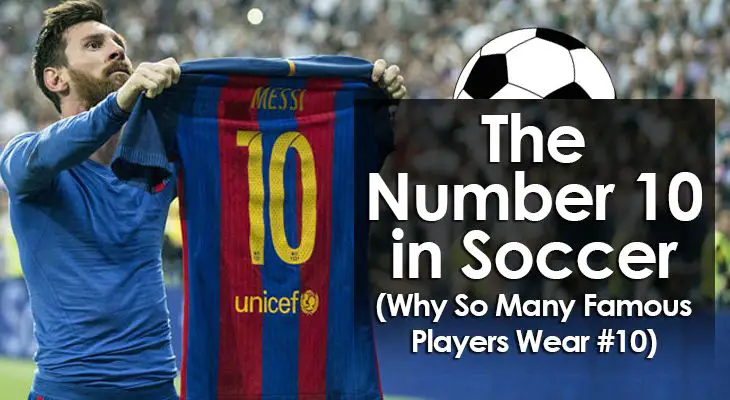What Position is the Number 10 in Soccer? (Role Explanation)
The number '10' is more than just a number when it comes to soccer.
There’s a certain "aura" that comes with it that naturally brings the assumption that the player is one of the best on the team.
This hasn't always been the case, though...
Originally, it was just one of the 11 numbers used to identify the position of a player on the pitch.
Each starting XI player had a shirt number assigned to them from 1 - 11.
The number 10 was usually reserved for one of the attacking players.
However, since soccer transcended from that singular purpose for jersey numbers, it has become more of a “prestige” tag.
Many attacking players nowadays aspire to have the “10” printed on the back of their shirts.
And there are good reasons for this...
For starters, some of the greatest players that the game has seen wore the number 10.
Some of the greatest moments in the history of soccer involved players sporting the famed number on the back of their shirts.
Let's explore some of the reasons why number '10' carries so much significance, and why so many famous players have worn it at some point in their careers.
A Brief History of the Number “10”
In modern soccer, the number 10 is usually seen to be the player occupying the space between midfielders and strikers -- in a 4-2-3-1 formation, for instance.
Things were quite different in the past though.
One of the most successful formations in earlier years was the 2-3-5 pyramid - two fullbacks, three half-backs, and five forwards.
In this formation, the number 10 was a left inside-forward that occupied the channel between the left-winger and the center forward.
As time passed and the game evolved, teams started to move away from the 2-3-5 formation.
They did this whilst keeping the numbering system as much as possible.
Numbers 2-6 were usually handed to defensive players (including holding midfielders).
On the other hand, teams reserved the numbers 7-11 for midfielders and forwards.
In the new 4-4-2 formation, the number 10 retained an attacking role - playing off or alongside the center forward in the number 9 position.
Usually, one of the two forwards would be an all-round attacking player while the other would mainly be a goalscorer.
At this stage, shirt numbers for the starting XI were still solely decided by the position of the player.
Once again, things took a different turn a bit later…

First, there was Pele...
If you’re a soccer fan, there is a very good chance that you’ve been in a debate about the greatest players to grace the game.
If that’s the case, chances are you’ve also heard the name “Pele” mentioned several times.
Usually alongside another soccer legend - Diego Maradona.
It is common knowledge that these two legends were two of the best to ever kick a ball.
The global recognition that they got for it stands strong to this day.
Pele and Maradona were two different types of players, but they had quite a few things in common too.
Apart from being attackers widely known for their genius level of skill and ability on the ball, they also both wore the number 10.
Both players donned the shirt for their countries and achieved a lot of success with it.
Pele won the World Cup 3 times as Brazil’s number 10, and Maradona won it once with Argentina in 1986.
In fact, the transfer of the number 10 to a 17-year-old Pele ahead of the 1958 World Cup is perhaps one of the most significant moments in history in relation to how people perceive the number in world soccer today.
Prior to that, the number was generally handed to the playmaker of the team.
So, the decision to hand it over to a young striker is unlikely to have been a popular one, but it paid off immeasurably.
Pele went on to score 77 goals in 92 games for the Seleção.
He also had an incredible club career with his local club side “Santos” and later, the “New York Cosmos”.
The success Pele achieved had a lot to do with other teams giving the number to their best players, instead of just the playmaker.
Diego Maradona wore the number 10 for various clubs throughout his career -- including Napoli, Barcelona, Sevilla, Newell’s Old Boys, and Boca Juniors.
His impact at Napoli was so massive that the club retired the shirt number when he left.
These two players - and many other legendary number 10s - are role models for many professional soccer players, fans, and young talents alike.
They are a major reason for the perception that the number has, and the levels of expectation that come with wearing it.
There are many other great number 10s in the game - both in the past and the present. Let’s have a look at some of them.
Famous Number 10s in Soccer History
Lionel Messi
Another gem from Argentina, walking in Diego Maradona’s footsteps and filling them very nicely indeed.
Many would even argue that Lionel Messi has outdone what the diminutive Napoli legend achieved.
He is not just one of the greatest number 10s to have played the game, he is one of the greatest players ever, period.
Lionel Messi did not start out as the number 10 for Barcelona.
But with the departure of Ronaldinho from the club, he was the natural candidate to fill in the Brazilian playmaker’s big boots.
It has all worked out very nicely, to say the least.
Ronaldinho Gaúcho (Ronaldo de Assis Moreira)
It’s almost impossible to think of flair and not think of Ronaldinho.
The Brazilian magician worked wonders with the ball at his feet.
His playful, endearing attitude to the game made him one of the most loved players on the planet.
Many players drew inspiration to build a career in the game because of the things that they saw him do with the ball.
He embodied the “Samba” style of play usually associated with Brazilian players and was an absolute joy to watch throughout his hugely successful career.
Zinedine Zidane
The tale of Zidane’s career is of two sides.
On one hand, he had one of the most successful careers of any player in the history of the round leather game.
On the other hand, that illustrious career ended in a very controversial manner - with a red card in a World Cup final.
He might have had a feisty side to his game, but he compensated for it with what he could do with the ball at his feet.
Zidane scored many world-class and title-winning goals in his time.
His style and elegance in possession of the ball from midfield was truly a thing of beauty.
Johan Cruyff
If there was a perfect definition for what a traditional number 10 was, the answer would be Johan Cruyff.
Apart from the fact that he was often the best player on the team, Cruyff was a true mastermind of playmaking.
He was best known for his ability to create space and lose his markers - sweet and calm as you like.
He did it so well that he even has a skill named after him - the Cruyff turn.
With out a doubt, one of the most creative players to ever grace the game.
Neymar (Neymar da Silva Santos Júnior)
A very similar type of player to Ronaldinho.
One might say Neymar is to Ronaldinho what Messi is to Maradona - such is the similarity that both players share.
Both players turned out for PSG and Barcelona, and both donned the number 10 at various points.
They are both Brazilian, and both have incredible skill with the ball.
It is no surprise then that Ronaldinho dubbed Neymar his heir as the star of the Brazil team following the Seleção’s Copa America final loss against Messi’s Argentina in mid-2021.
Conclusion
Wearing the number 10 shirt might come with some level of “prestige”, but it does not automatically make a great player.
There are many instances of players that wore the shirt for their teams and failed to make a difference, but that’s a story for another day.
Becoming a great soccer player goes far beyond the number on the back of your shirt.
It involves a ton of hard work, dedication, discipline, attention to detail, and willingness to learn.
If you can get all that checked off your list, then you’re on the right track to making a name for yourself in the game, regardless of your number!

